Real-estate Developers Say Community Is a High Priority
“We recognize real estate here is more about people than it is about dirt,” Jared Della Valle, CEO of the Brooklyn real-estate development firm Alloy, said this week in a meeting of his industry colleagues. “We’re starting to address the community, and to think about the needs of place in a much more relevant way—issues of affordability, domicile, and what real estate really is about, which is the fundamental need for home.”
Della Valle has learned a thing or two about fitting into the borough, as the developer behind the award-winning One John St. condo building in Dumbo and the much-debated 80 Flatbush mega-project in Downtown Brooklyn. His comments summed up an essential challenge in real-estate development today, especially in a borough where gentrification is a charged political issue. Developers need to embrace community needs, while navigating economic forces and a changing regulatory climate, he and his fellow speakers said at the Only Brooklyn real-estate conference this week at the Alamo Drafthouse Cinema in City Point.
The annual conference took place against a backdrop of continued growth in the Brooklyn market, even if the feverish rise in residential prices has cooled off. A first-quarter report from Corcoran showed residential-sales volume easing, while StreetEasy reported high rental demand—three of the hottest six neighborhoods across the city were Dumbo, Downtown Brooklyn and Brooklyn Heights. The city’s third- and fourth-largest new residential developments will be in Brooklyn, at 545 Vanderbilt Ave. and 1911 Atlantic Ave., reported The Real Deal.
On the commercial-property side of the business, a 2018 year-end market report published by TerraCRG, the firm that hosts the Only Brooklyn conference, showed strong growth. “The Brooklyn commercial real estate market remains active with $7.4 billion in total dollar volume, a 15% uptick from 2017. That figure is consistent across a five-year basis,” the report said. “This activity has foreshadowed what has already been a vibrant start to 2019.”
Development Will Be Dynamic
It was under such favorable conditions that several hundred members of the local real-estate industry gathered to discuss the borough’s future, starting with a panel titled “Brooklyn’s New Vision,” moderated by TerraCRG founder Ofer Cohen. After developer Della Valle spoke about community needs, Cohen called on Eran Chen, founding principal of ODA architecture for insight into how this cooperation could manifest itself. Chen’s firm is behind Denizen, a mixed-use complex on the site of the old Rheingold Brewery in Bushwick that will include 20% of its residential units deemed affordable, communal spaces, a public park, and commissioned art by local artists.
“There’s three main principles that are relevant to people today,” Chen began. “The first one is a balance of density and open space. And that’s something we all know about, but we tend to forget as we develop cities [and] quality public spaces. The other thing is infrastructure, and the third thing is people want to live in a mixed-use environment.”
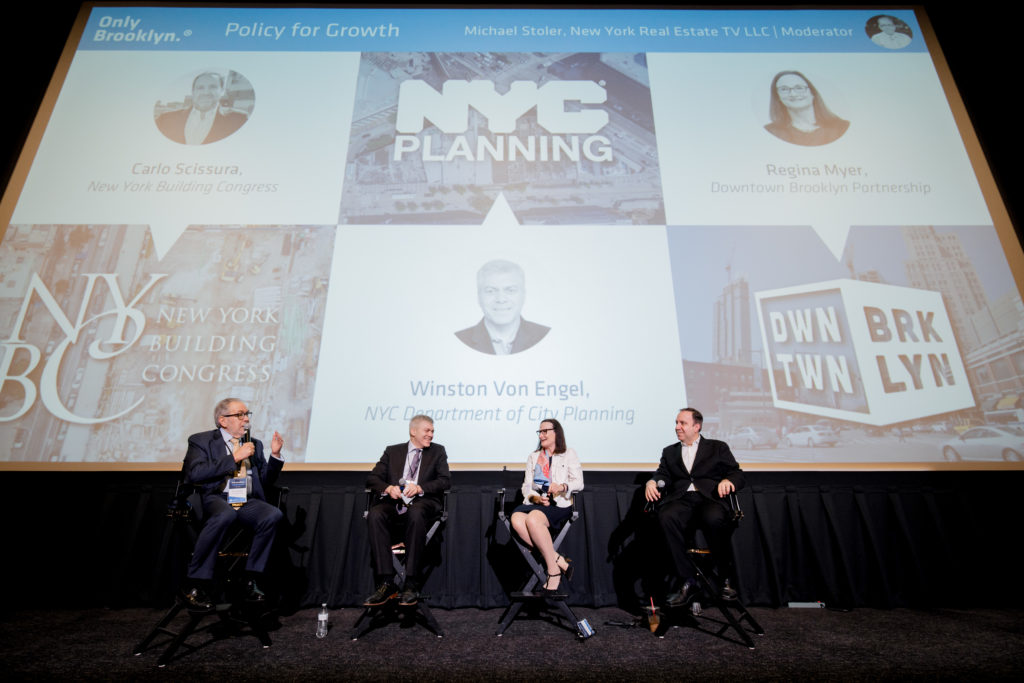
Chen noted that parts of Manhattan are so dense that it is extremely challenging for developers to implement these refined spaces with desirable personalities. “Brooklyn provides us the opportunity to actually rethink those priorities and do it the right way, in a way that addresses people’s needs of today and how people want to live today.”
Jeff Mandel, head of acquisitions at Tishman Speyer, a Manhattan real-estate giant that’s constructing an office tower atop the Macy’s building on Fulton Mall, took the conversation down a more tech-centered path. “What I would imagine moving forward for Brooklyn is that it’s a place really characterized by innovation. We have innovative people here,” he said. “So what I’m really thinking about is there will be a more mature economy of businesses that choose to make Brooklyn their home, and that’ll potentially be a function of the engines and the people that are already here, starting businesses—not unlike Etsy, for example.”
Fortunately, Brooklyn appears to be an ideal place for developments meeting such a variety of needs. “You go around the world, every great city is a collection of great neighborhoods. [In Brooklyn] you have that, so you have a phenomenal canvas, naturally,” said Ben Brown, head of New York for Brookfield Property Partners, a global real- estate investment firm. “Now you have a lot of capital being invested in these different pockets to create these neighborhoods and take that maturation process on. I think the future of these particular neighborhoods will evolve and change, and [yet] continue to be distinctly themselves.”
After the panel wrapped up, The Bridge asked Cohen about the relative importance of real-estate developers being conscientious community partners. “There’s a level of commitment that Brooklyn is a place that we need to continue to shape, and I think that gives you [a sense of] responsibility,” he said. Local developments popping up today, he continued, are better fits for the area because the people involved in cultivating them are “understanding the economics, the demographics, the changes and the shifts from within” the borough.
Are Regulations Becoming Excessive?
In another panel, “Policy for Growth,” moderator Michael Stoler, president of New York Real Estate TV, asked panelists about the futures of specific Brooklyn neighborhoods and the impact of new city regulations, including the Climate Mobilization Act, which will require sharply reduced building emissions. Stoler asked: “How do we get growth when we have all this potential legislation?”
“Of course everybody wants to live in a green world,” said Carlo Scissura, CEO of the New York Building Congress, a construction-industry trade association. “People like all of you in this room, and people like us [on the panel] really need to let the elected [officials] know … that one regulation is O.K. But now that it’s added up to eight, 10, 12, 15 regulations, the sunny skies of Miami are looking pretty good, the warm weather of Texas is not bad. We all have to really come together and say enough is enough.”
Good for Business: Rezonings and Transit
While the prospect of taking their business elsewhere may be tempting, other regulatory developments in the city provide opportunities, notably the rezoning of neighborhoods for broader uses. Winston Von Engel, director of the Brooklyn borough office of the Department of City Planning, pointed to the recent rezoning of East New York as a promising indicator that plenty more rezonings—and, thus, developments—are on the way. “We kind of held our breath [as to] whether it would take, and it’s taking,” Von Engel said, speaking on behalf of his department and the mayor’s office.
“The private sector is actually responding—they’re building, they’re developing sites and building housing with affordable housing.” He added that retail is returning to East New York as well, and that the city is building a new school there, though he later admitted, “It’s going to take some time” for the neighborhood to evolve to the potential its rezoning affords.

Stoler asked which recently proposed zoning plans were the most likely to pass. Von Engel emerged bullish on Gowanus. “That’s one of the imminent rezonings,” he said. “We just put out a zoning framework; we had our environmental kickoff meeting just a few weeks ago.” While local residents criticized the plan at that meeting, calling for environment cleanup of the toxic Gowanus Canal to be emphasized over residential development, Von Engel portrayed Gowanus as brimming with potential.
“I think Gowanus is a great example of an effort to refresh and revitalize an area, and there’s something unique and new about it.” Von Engel noted the distinct mix of industrial and commercial buildings already present there, supplying walk-to-work possibilities for residents. “That’s what [the Gowanus rezoning] is about—the mixing of the uses, and actually increasing and innovatively allowing for a new creative industrial district to foster more job growth as well as housing.”
Though Downtown Brooklyn has been revitalized the past decade or so, Regina Myer, president of the Downtown Brooklyn Partnership, which manages the three business-improvement districts in the area, said more improvements are still being considered—also by way of rezoning. “We have 15,000 new housing units in Downtown Brooklyn; we have an entirely dynamic downtown, which we did not have 15 years ago,” Myer said. “What we need now is more office space.” (An earlier rezoning produced abundant residential towers, but not the expected office buildings.)
Myer said new upzonings could propel projects like 625 Fulton Street, a proposed 941-foot tower with 739,000 sq. ft. of office space, and 570 Fulton Street, a 40-story mixed-use building; and a planned 500,000-sq.-ft. development, also along Fulton Street. Such additions could give Downtown Brooklyn the chance to have a “true office center” and help boost the neighborhood’s recently moved-in retail stores.
The panel also discussed how improvements in transit, including the lingering prospect of the BQX streetcar, which would run from Astoria, Queens, through Gowanus; ferries between Manhattan and Coney Island, Red Hook, and other Brooklyn enclaves; and the soon-to-open second span of the Kosciuszko Bridge, should have a noteworthy positive impact on development in those benefitting areas.
The brightening prospect for transit prompted Scissura to declare: “Endless opportunities are out there” for development. Asked after the panel to reconcile that idea with his concerns about regulation, Scissura said, “It’s still New York, and people still want to be here. So I think our job, collectively, is to say, as regulations are announced or talked about, ‘How do we continue to make sure that they are not stopping development and opportunity?’ I would like government to ensure that we’re doing things safely and in the right manner, but to not regulate every piece of this industry, so that we can see the continued boom in construction and development that we’re seeing today.”
The Pitch Contest: When Tech Startups Go Head to Head
If you polled people on the street today and asked them which cities are the “most successful homes for tech and start-up companies,” the first one that would come to mind for most is probably San Francisco, with its already storied Silicon Valley grandeur tipping the scales. But that’s not the municipality topping the list in a new study on the topic by Savills, a leading global real-estate service provider. It’s New York City.
“New York got points for its venture capital investment, which was billions of dollars greater than in San Francisco over the past three years,” Bloomberg said about the report. “That and plentiful transportation options helped offset the city’s poor score for real estate costs.”
Another important factor according to the study: New York’s access to talent, some of which was on bright display during a Shark Tank-inspired pitch competition last week.
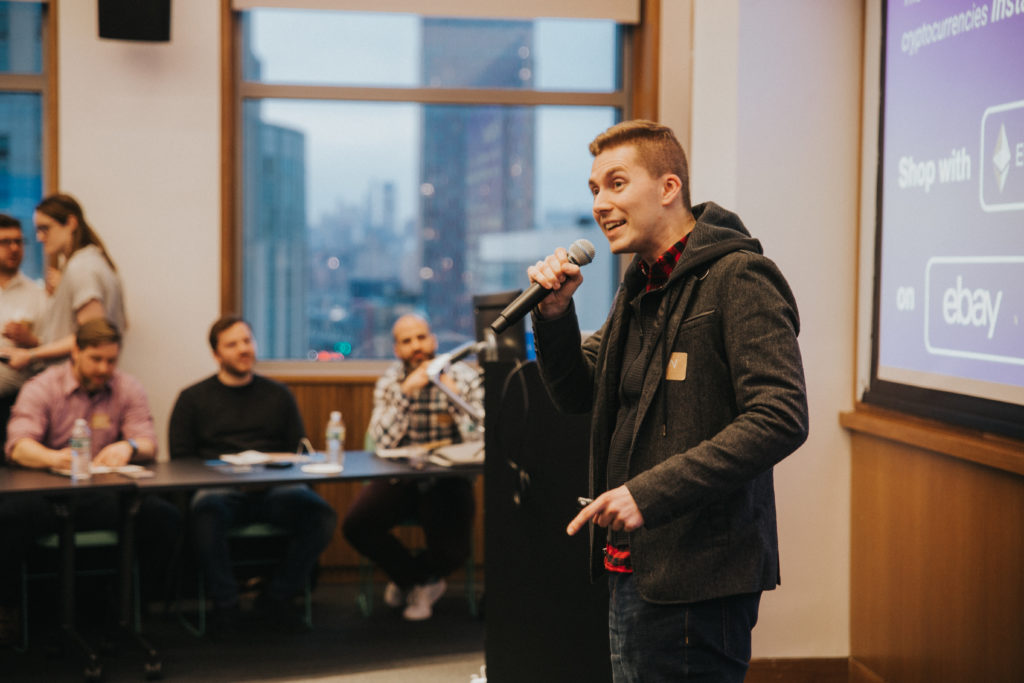
Coordinated by the Downtown Brooklyn Partnership, an organization that supports business interests and improvements in the area, and set at the NYU Center for Urban Science + Progress (CUSP) on Jay Street, the Make It in Brooklyn FinTech pitch contest pitted five start-up entrepreneurs against one another, vying for a $5,000 cash prize. To win, all they had to do was convince five judges, over the course of just a three-minute pitch and a few Q&A exchanges, that their company could be the next tech-industry giant.
“I think the purpose is to really put the spotlight on how much innovation is happening in Brooklyn,” said Regina Myer, president of the Downtown Brooklyn Partnership. “Having places where people can come together, exchange ideas, recognize each other and build a community is really what the partnership is all about.”
Myer also opined that, even though the contest would produce a lone prizewinner, it offered the chance for all the contestants to practice pitching, with feedback provided by industry-insider judges. It was also an opportunity for the company leaders to show others in the local tech landscape the cutting-edge innovations they’re hatching in the realm of financial technology, or FinTech.
“Even if they don’t win, somebody might be in the audience who says, ‘Hey, I want to learn more’ or ‘I want to support them,’” Myer observed.
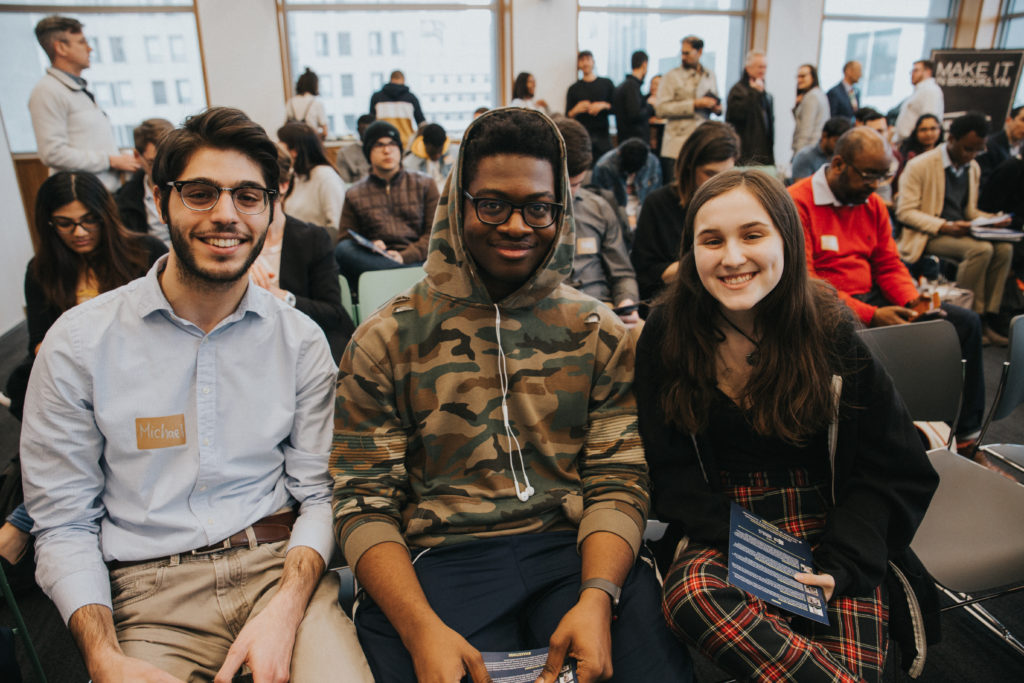
First up was Mik Breiterman-Loader, cofounder and CEO of Vestive, a company developing an investing platform that “helps people reach their financial goals, while considering environmental and social impact.” He explained how the platform efficiently helps investors buy into companies while reducing their carbon footprint, promoting diverse leadership and alternative energy solutions, and more.
After the presentation, Hatice Uzan, professor of finance at LIU Brooklyn, asked Breiterman-Loader, “What is your company’s biggest advantage over competitors?” to which he responded, in part: “Being sustainable across [a wide variety of] metrics, as well as keeping pace with financial returns.”
Once the round of questions for Breiterman-Loader wrapped, it was Madeleine Barr’s turn to take the mic and toggle through a PowerPoint presentation. The co-founder and CEO of Piecewise described what inspired the formation of her company: her own student debt, and the fact that around 40% of students are expected to default on their loans in the near future, dramatically harming their credit standing.
“The average debt-repayment lifetime is about 22 years [and] we stay with them through that, making personalized payment recommendations based on what they can afford,” said Barr of her company’s repayment platform, which is designed to prevent defaults.
Looking for clues as to Piecewise’s true viability, Jeremy Harper, principal at Entrepreneurs Roundtable Accelerator, asked about the platform’s benefits for schools.
Barr was prepared.
“If a school’s default rate for their alumni gets too high, they lose the ability to offer federal loans to their students,” she said assuredly. “And nowadays 70% of students take out federal loans to go to schools, so the schools have a huge imperative to lower default rates.”
Another contestant, Sam Wils, outlined his WingaDoos digital application for schools and parents. WingaDoos uses animated characters to teach kids lessons about the basic principles of money—more important now than ever with the cultural disappearance of hard cash.

Then, Michael Hatoum described how his company, WalletWorth, provides “a platform that allows everyone, from everyday savers to curious investors, to make better judgments on existing financial services,” he said. WalletWorth compares “different savings and investment vehicles to help people find the best rates for them based on a set of criteria—their initial deposit amount, their financial goals, risk tolerance, and bank preferences.”
And finally, Ken Kruger, founder and CEO of Moon, explained how his company’s web browser extension instantly converts cryptocurrency into real dollars during internet purchases.
Among many questions, judges asked each founder how they might keep prospective competitors from copying their product, should it achieve success; about user-number data; and if they’ve accrued data on outcomes.
After the judges deliberated, while attendees feasted on dumplings, it was time to announce the winner.
Judge Jon Zanoff, who leads the Barclays Accelerator, powered by Techstars, did the honors. “One of the things we were unanimous about is that there are really only two types of people: entrepreneurs and everyone else,” he said, sparking laughs. “You’re the ones in the arena, staying up at night, fighting for this, giving up what, no doubt, would be high-paying jobs to deliver something you believe in. So thank you so much.”
Based on factors that included “passion for the solution, not just the pitch,” according to Zanoff, and the presence of diversity on founding teams, the judges awarded first prize to Piecewise, founded by Barr and Reshad Monsur.
“It’s always hard to come into a room with a mindset of These people have no idea what you’re doing; how can you explain it the best?,” Barr, told The Bridge afterward. “But I think we’re lucky to be working on a problem that resonates with so many people, that the passion really does come through. I think as long as you’re genuine and authentic, everything else comes out; it’s much more about the persistence than making sure that you check every box.”
For her co-founder, the cash prize was a footnote to the validating experience. “We go into every competition, every pitch, every meeting like, This is our last chance,” Monsur said. “We want to savor everything, and it doesn’t matter if it’s $5,000 or $50.”
Given Piecewise’s recognition among insiders in the city’s tech world, often called Silicon Alley, they’ll likely have plenty more chances to show prospective investors what they’re capable of.
“Tonight and every night in New York City there might be a dozen pitch nights, so the entrepreneur journey is real, the fire is real,” Zanoff told The Bridge. “I couldn’t be more excited about Silicon Alley, and the future of tech in general in New York City.”
Inside Dock 72, Brooklyn’s Most Nautical Office Building
Imagine finishing the workday, and instead of heading to the local tavern for a drink, you go downstairs to the lounge, where there’s a full-service bar. Imagine needing to hit the gym before work and instead of detouring on the way to work, you can stop off on the second floor of your office building, which is equipped with its own gym. Need some fresh air after hours of staring at your laptop? You could pop into the building’s backyard, complete with a basketball court and green space.
For some New Yorkers, this all-in-one workplace will become a reality when the new Dock 72 building opens in the Brooklyn Navy Yard later this year. The 675,000-sq.-ft. structure will have 35,000 sq. ft. of amenities, meant to provide workers with a healthier and more productive environment than a traditional office space.
The building, developed by Boston Properties, Rudin Management Co. and WeWork, and designed by S9 Architecture, is 16 stories tall and is surrounded on three sides by water, like a ship that has pulled up to the East River shoreline. Unlike most other projects in the Navy Yard, Dock 72 was built from the ground up instead of being a repurposed building.

Built in the center of a manufacturing hub, situating Dock 72 between two dry docks creates an “authentic environment,” said Andrew Levin, senior vice president of leasing for Boston Properties. The abundance of amenities and open floor plans are part of the plan to boost worker productivity and well-being, while increasing collaboration, he said.
Dock 72, which will accommodate 3,000 to 5,000 workers, is part of the Navy Yard’s largest expansion since World War II, where several developing projects are expected to add a total of 10,000 jobs to the complex by next year. A Wegmans supermarket is being developed on the Admirals Row site, Steiner Studios is expanding its sound stages, and the Navy Yard’s largest development, Building 77, has been refurbished for manufacturing, technology and design businesses.
Dock 72’s design resembles a large vessel loaded with shipping containers, a nod to the Navy Yard’s history of shipbuilding. Levels are set back to create more outdoor space for tenants.
Since the building is right on the water, developers had to design Dock 72 to be resilient to flood risks, Levin said. That’s why the building is perched eight feet above the ground on V-shaped columns. Furthermore, the building’s mechanical systems are installed on the second floor, 19 feet above the floodplain.
An Abundance of Natural Light
Inside the building, Dock 72 is designed to be the opposite of stuffy. The office space has 14-foot ceiling heights and eight-foot windows to maximize natural lighting and air flow. With open-floor plans, there aren’t many walls or pillars that obstruct natural light from seeping in. What’s more, Dock 72 is only 90 feet wide, which means tenants are always within 45 feet of a window.
Some floors have private terraces, which make up 18,000 sq. ft. of the building. Adorned with gardens, they provide sweeping views of the Manhattan and Brooklyn skylines. The building includes a conference room capable of accommodating 200 people, along with a separate rooftop conference room.
Dock 72’s anchor tenant, WeWork, has leased about one third of the building, laying claim to the third through eighth floors. The company has more than 500 outposts around the world, including 59 in New York City. Dock 72 will be WeWork’s fifth building in Brooklyn.
A Tour of the Building in Progress
When walking into the building’s east entrance, employees and visitors will be greeted by murals created by Brooklyn artists. The lobby, spanning from the east entrance to the west entrance, doubles as a lounge area, complete with low seating and high-top seating.
There are two cores, one near each of the entrances, where turnstiles lead to elevators. A front desk is near the center of the building, just in front of the grand staircase, which houses a coffee and espresso bar underneath it. Behind the staircase on the building’s south side is a food hall and lounge area equipped with a bar.
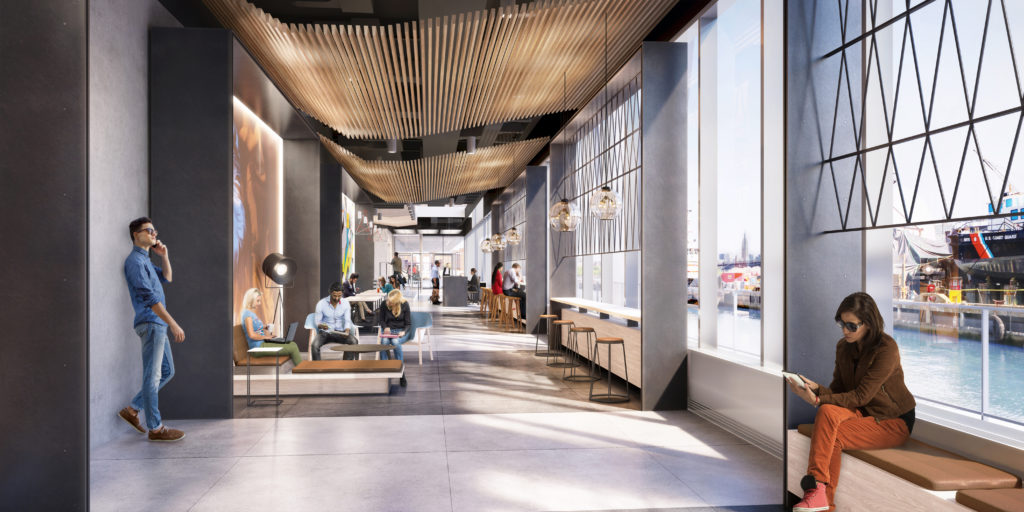
Outside is the basketball court, green space and bleacher seating, alongside a 150-foot mural created by Brooklyn youth through the nonprofit Creative Art Works. Inside, the grand staircase from the lobby leads to the 15,000-sq.-ft. fitness center and juice bar, which face the East River and Manhattan.
Dock 72 workers will have a variety of ways to commute. A new NYC Ferry stop will be right outside Dock 72’s west entrance, connecting riders to Wall Street and 34th Street in Manhattan.
The Navy Yard’s shuttle service connects workers to several nearby subway stations. Dock 72 comes with its own designated parking lot too, with about 100 spaces and 24 electric-car charging stations. For bike riders, there’s an on-site valet, as well as a Citi Bike dock right near the building.
With all the amenities and other features, the developers decided the building needed its own app to tie it all together, Levin said. It was inspired by WeWork, which has an app of its own for its tenants around the globe. With Dock 72’s unique features, however, there wasn’t an app on the market that would fully fit the needs of its tenants, “so we created one ourselves,” he said.
Workers will be able to order food and beverages from the food hall, connect with the bike valet, reserve a conference room, sign up for exercise classes, and get real-time updates on train, ferry and shuttle times.
How Brooklyn Became the New Hotspot for High-profile Events
The Brooklyn brand’s evolution from gritty to glamorous has reached a new chapter.
For years the borough was best known as an artisanal landscape, where upstart craftspeople injected the perfect rustic-chic aesthetic blend into everything from beer to bracelets to luxury bedding.
But with corporatization afoot, and the local economy positioned among the country’s most enviable, Brooklyn is also becoming home to many high-profile events typically reserved for the bright lights of Manhattan, from awards shows to business conferences.
Case in point: tomorrow evening, Brooklyn Steel, the cavernous East Williamsburg music venue, welcomes the National Magazine Awards, known as the Ellies. The splashy ceremony, giving out the magazine industry’s counterpart to the Pulitzers, has previously taken place at such august Manhattan venues as the Waldorf Astoria hotel and Jazz at Lincoln Center.
Now it’s Brooklyn Steel’s turn. That venue, which opened a little less than two years ago, has already been named one of the ten-best live music venues in America by Rolling Stone, right up there with the Hollywood Bowl. In predictably Brooklyn fashion, its name was inspired by the space’s industrial look, dating back to its steel-manufacturing origins and preserved throughout the building’s recent reimagining.

“Brooklyn is crawling with magazine people, so they’re happy,” said Sid Holt, chief executive of the American Society of Magazine Editors (ASME), in an email to The Bridge about the Ellies’ migration to the outer borough. “I’m happy because it gives me a chance to bore my Manhattan-born kids with more stories about their Brooklyn Dutch ancestors. Everybody else is happy because they’ll be able to spend a Thursday night in Williamsburg.”
Holt also conceded that ASME’s moving of the Ellies from Manhattan was financially and spiritually motivated, pointing to Brooklyn’s enduringly accessible and not-so-serious splendor.
“ASME wanted to cut ticket prices so more people could attend and wanted to provide more opportunity for people to socialize,” Holt said. “We also wanted to make it more of a celebration and less of a ceremony. The venues we had used in the past didn’t really lend themselves to the kind of event we had in mind.” He added that sending the awards across the East River signaled to attendees “this was a new kind of Ellies.”
The magazine awards are just the latest arrival in a parade of events coming to Brooklyn, from splashy to serious. The trend is driven not just by Brooklyn’s slightly exotic alternative vibe, but by an array of new venues including elegantly repurposed spaces like the Weylin, formerly the Williamsburg Savings Bank; glamorized warehouses like those run by Gowanus Hospitality Group; and swanky new lodging like the Williamsburg Hotel.
The Kings Theatre on Flatbush Avenue, coming off a $95 million renovation and a reopening four years ago, hosted Glamour magazine’s “Women of the Year” awards in late 2017. Honorees included actress Nicole Kidman, late-night TV host Samantha Bee, supermodel Gigi Hadid, and singer-songwriter Solange Knowles, sister to Beyoncé.
Returning this June to the 1 Hotel Brooklyn Bridge—the upscale lodging company’s flagship at Pier 1 in Brooklyn Bridge Park, which opened two years ago and sports some rooms that go for nearly $2,000 a night—is the New Rules Summit, nosted by the New York Times. Last year’s inaugural conference, about “Women, Leadership and a Playbook for Change,” attracted dozens of influencers from a series of industries, including journalist and author Katie Couric, actress and activist America Ferrara, charity foundation co-chair Melinda Gates, and Girlboss founder Sophia Amoruso.
Scheduled to appear at the summit this year are some of journalism’s heaviest hitters from the Times, including White House correspondent Maggie Haberman, Washington bureau chief Elisabeth Bumiller, and deputy managing editor Rebecca Blumenstein.
For many of the people drawn to the events, it’s their first look at Brooklyn’s transformation, according to Hans Schaepman, the 1 Hotel’s general manager. “What stands out when 1 Hotel Brooklyn Bridge hosts these high-profile events is the surprise both from organizers as well as event attendees. They love how well integrated the hotel is with all of the waterfront park and and how we ‘pull the outside in,’” he told The Bridge in an email. “Many guests are surprised about the development of the Dumbo area in general.”
But Brooklyn’s cachet isn’t only attracting media-industry players. Hillary Clinton and Bernie Sanders engaged in a waterfront debate at the Brooklyn Navy Yard during the 2016 Presidential campaign. There was the Brooklyn Museum’s David Bowie dance party this past May, where 2,000 attendees paid tribute to the music icon by dressing up like the “Starman,” as the museum’s expansive, world-class exhibit on him neared closing.
A few weeks after that, the museum welcomed the fashion industry for the Council of Fashion Designers of America awards, which saw Kim Kardashian-West honored as an influencer and Oprah Winfrey present a media award to British Vogue editor-in-chief Edward Enninful. Then, days later, in a display of Brooklyn’s crossover appeal from the arts and culture into sports, Barclays Center hosted the NBA Draft for the sixth consecutive year.
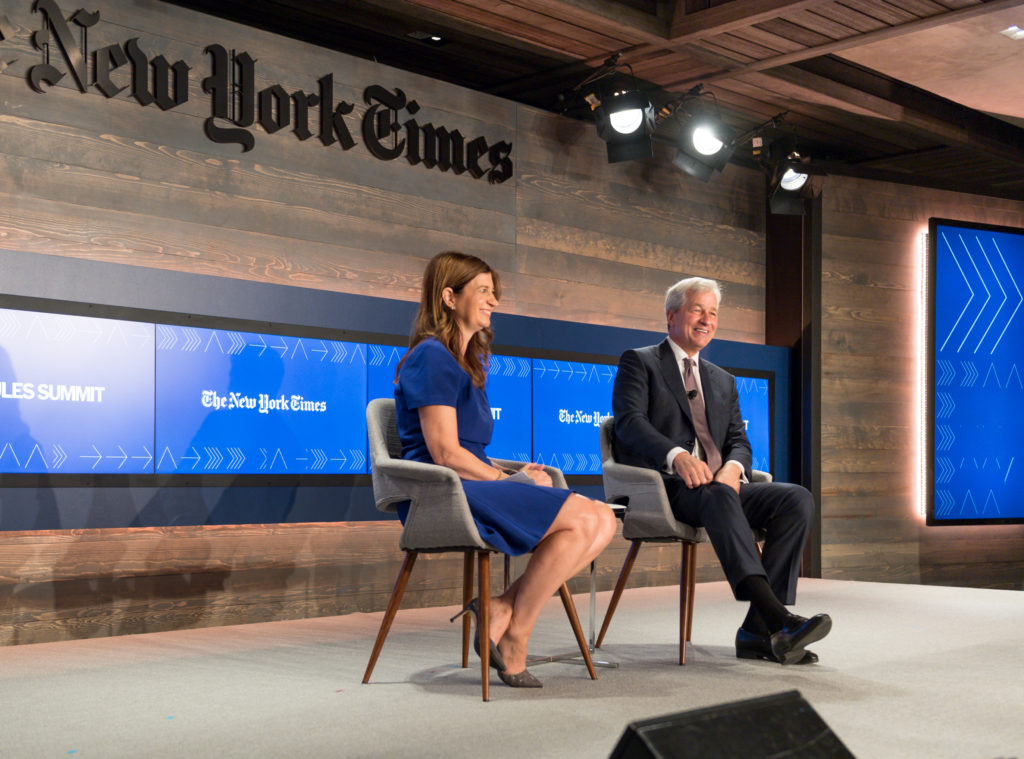
Brooklyn’s boosters see a powerful mix of influences driving the trend. “As the city’s nexus for culture and diversity, commerce and innovation, Brooklyn is the natural destination for headline events that shape the future of their industries,” Hector Batista, president and CEO of the Brooklyn Chamber of Commerce, told The Bridge. “There’s no better home for high-profile events than Brooklyn.”
Batista indicated that these types of events help spur economic growth in surrounding areas, often to the benefit of local businesses. And revenue begets more revenue. The borough’s infrastructural ability to contend with Manhattan—as well as other cities—has dramatically improved the past half-decade. Besides the restoration of iconic buildings, the borough has seen the addition of entirely new venues like the 68,000-sq.-ft., Brooklyn Expo Center in Greenpoint, a more intimate version of the Javits Center.
Other venues include Williamsburg’s Brooklyn Bowl, which at ten years old seems practically ancient among these ranks, and will once again host the Relix Live Music Conference, as it did last year. Pioneer Works, the cultural center in Red Hook, is where the Ethereal Summit, covering all things blockchain tech, will land in May. BRIC, the cultural arts center in Downtown Brooklyn, is a popular draw as well, and in June will host the second edition of the From Day One conference, which is co-founded by the proprietor of The Bridge.
Besides all the welcoming new venues, it’s about what’s happening inside them that’s creating critical mass. As Sid Holt put it: “Well, it really is where the action is.”
What If the Tech Boom Sputters? How Startups Can Prepare
Tech’s success has been atomic since the Great Recession. Innovations in artificial intelligence, cloud computing, cryptocurrency, wireless, and other sectors the past decade have helped justify waves of cash flowing into the industry, made more readily available thanks to low interest rates from the Federal Reserve. Brooklyn has been a beneficiary of the boom, especially in the area dubbed the Brooklyn Tech Triangle.
But tech bubbles have burst before, most notably in 2000, which helped spark the new decade’s first recession. Now there are signs that the latest boom could be cooling off, along with a slowdown in the overall economy. Citing softening returns at Apple, Nvidia, Intel, Samsung and other key players, the New York Times intoned recently, “Storm clouds are gathering over tech.”
With those forecasts in mind, the Downtown Brooklyn Partnership, an organization that supports business interests and improvements in the area, organized a talk at Hank’s Saloon at Hill Country Food Park this week with guest J.J. Kasper, co-founder of Blue Collective, a tech-focused venture capital firm based in the borough.

“Brooklyn is increasingly full of entrepreneurs and start-uppers,” said Tyler Woods, the partnership’s director of network, who coordinated the event and played host. He noted that Downtown Brooklyn, Dumbo, Williamsburg, and Bushwick have enjoyed an influx of tech companies entering the area lately, bypassing Manhattan. “The East River is not as much of a barrier in the tech world as it would have been 10 or 15 years ago.”
The talk, titled “How the Startup World Changes in a Down Market and How to Adapt,” explored what the next downturn might look like, how Brooklyn entrepreneurs can prepare, and even the investment advantages that may arise in the midst of a slowdown. Among the takeaways:
Downturns Can Provide Opportunities
While most economists and business leaders think 2019 won’t bring a recession, which is defined as a period of time when the economy actually shrinks, a slowdown in the growth of business and consumer spending brings notable changes to the economy.
When such events occur, startups and venture capitalists (VCs), if they have the means, should swing into action, Kasper said.
“When you look back over down markets, the VC industry, specifically, and in respect to start-ups, is really well-insulated against down markets, which is kind of confusing and counterintuitive,” Kasper said. “The primary reason for that is the supply of venture capital is fairly fixed.”
A VC firm’s business model typically involves raising a fund that falls into an investment period that lasts between three to five years, sometimes longer.
“So even if there is a downturn, I actually still have that money there,” Kasper said. “And we are particularly insulated right now, and that’s actually because, over the last five years, fundraising in VC has just gone through the roof, in the same way that dollars deployed has gone through the roof.”
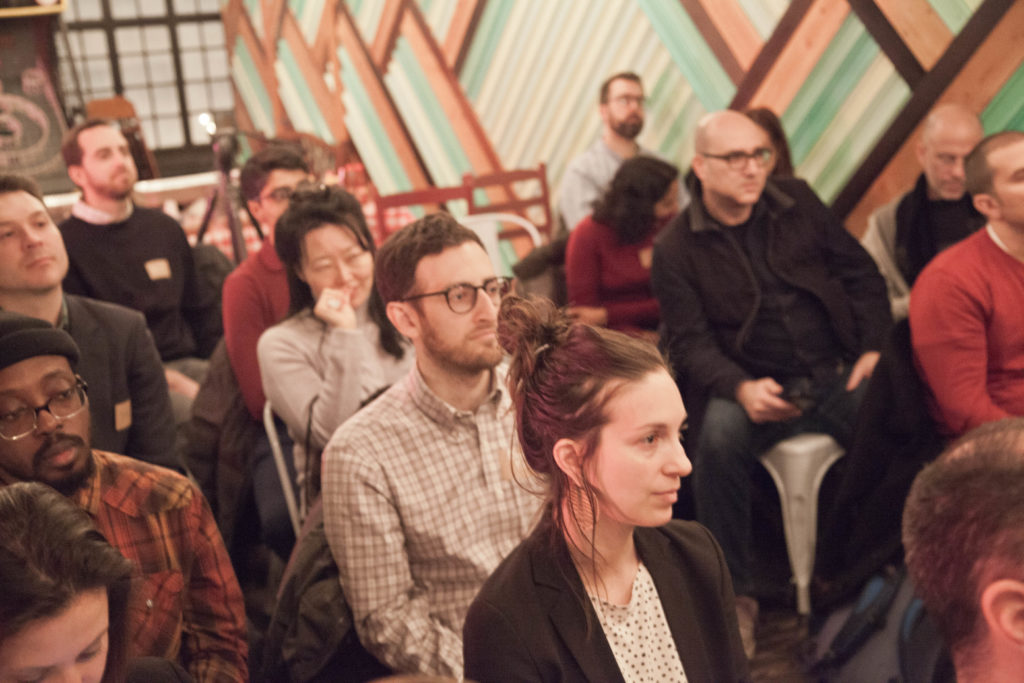
Experts say that 2018 was a record-breaking year for venture capital in the U.S., which saw VCs investing around $130 billion.
So in troubling economic times, with costs lower and capital still around, investment opportunities can be ripe—with fatter return-on-investment potential.
“In down markets, this is actually when you see the best companies pop up,” Kasper said. “A down market’s good for us. There’s fewer competitors out there on the VC side, [and] the entrepreneurs in that market are the more true believers.”
“For entrepreneurs who are thinking about starting something,” he continued, “I’d say in a down market, those who make the leap into entrepreneurialism … while it’s going to be a tougher lift in the beginning, those tend to be the entrepreneurs we remember, and they tend to be those who really, really want it.”
Kasper cited the founders of Airbnb and Uber as people who got ultimately highly profitable companies off the ground during the Great Recession.
Turning a Profit Could Be Harder
“If there’s less money to go around, who’s hurt most?” Woods later asked Kasper.
As consumers do, businesses facing a slowdown cut back on discretionary spending, Kasper said. So young businesses may find revenue more elusive.
“The people who are the most exposed are entrepreneurs already in the flow,” Kasper said, “people who are out there, who’ve raised money and have products and services that they are pitching to customers or businesses.”
That said, Kasper added, “It doesn’t mean every startup gets hurt; some are providing extremely valuable services that are super sticky, that have been around for a while.”
“Some have [strong] cost-value relative to the money that you spend for it,” he continued. “But in a downturn there certainly is some reckoning that’s going to occur in the startup world, and probably those who don’t have the capitalization to survive that, those who maybe have charted for a path of growth at all costs,” will run into trouble.
To avoid such a fallout, companies need to “have a path to profitability in your back pocket,” Kasper said.
“This is way harder said than done,” Kasper conceded. “If you have positive unit economics, that’s great, that’s a big plus, and if push comes to shove you can probably re-orient around that. If you don’t … and you’re in-market, you should probably get there sooner rather than later. … One way is cut costs and the other way is figure out what the revenue model is.”
Limited Partners Could Get Cold Feet
VCs have to get their money from somewhere, and often it arrives via limited partnerships (LPs), which can be individuals, pension funds or other organizations with money to invest. If the LPs start to see unfavorable conditions, they could start throttling back.
“It’s a matter of scarce resources on the LP side and them trying to protect their overall returns,” Kasper said. He then hypothesized that if LPs sense a down market on the horizon, the VCs they’ve worked with recently could be among the first investments they move away from. Instead, the LPs may put more of their money into bonds or more established equities.
However, according to Kasper, there are some LPs that continue to invest even in a down market. “There certainly are folks who will just say, ‘Let it ride,’” Kasper said, “and I would guess actually those are the ones who end up doing quite well.”
To learn about upcoming Downtown Brooklyn Partnership events, visit their website.
Will Brooklyn’s Freight Trains Get Rolling Again?
On occasional moments of quiet in Brooklyn, when the sounds of honking horns and garbage trucks die down, residents can hear the lonely whistle of a freight train. Many might wonder where it’s coming from, since lines of boxcars are not a familiar sight in Kings County.
The answer is that a few freight trains still roll along the Bay Ridge Branch of the New York & Atlantic Railway, typically carrying goods bound for points east. The 12-mile stretch of track snakes across the borough from the harbor just south of the Brooklyn Army Terminal, through the low-rise blocks of Borough Park, past Brooklyn College’s stately campus, and through industrial zones in Flatlands, Canarsie and East New York, before terminating at a yard in Glendale, Queens.
For much of its length, the Bay Ridge line is hidden behind overgrowth and fencing. With the exception of once or twice a day when a train rattles by, the line gives neighbors and passersby no indication that it’s alive.
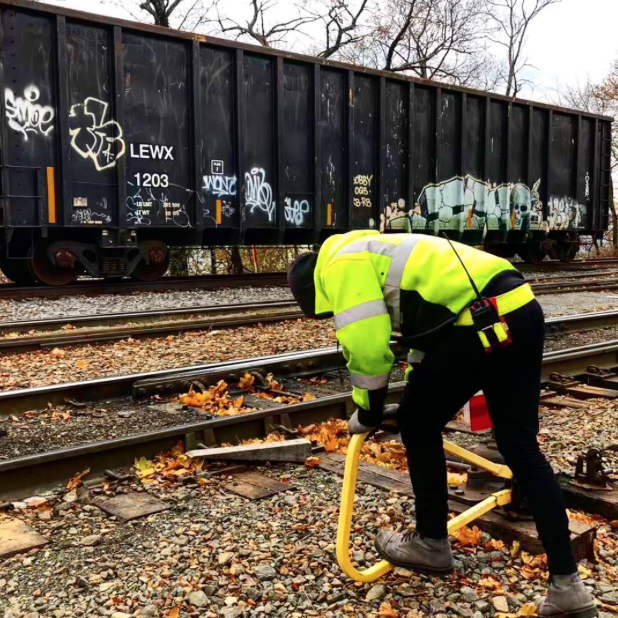
It wasn’t always like this. In its heyday from the beginning of the 20th century through the mid 1960s, freight and passenger trains shared the tracks, carrying commuters and commodities, reportedly at a rate of up to 30,000 cars a year. That’s ten times the line’s current average of 3,000 freight-only railcars per year, according to James Bonner, the New York & Atlantic Railway’s president.
“As manufacturing in New York City and on Long Island declined, and better roads and interstate access materialized, volume declined significantly,” Bonner said, as the economy shifted to a reliance on trucks for the movement of goods. Today, about 90% of all freight going in or out of New York City is carried by tractor-trailer trucks, which contributes to congestion, damage to infrastructure, and environmental harm.

But now freight-rail advocates see a golden opportunity for growth along the Bay Ridge line, thanks to a city’s Freight NYC initiative, a $100 million plan to modernize the city’s freight-distribution system. The plan, from the city’s Economic Development Corp. (NYC EDC), aims to rejigger the region’s transportation infrastructure to spur greater use of boats and trains in the shipment of the 400 million tons of freight that flow in and out of the city each year.
Improvements to the rail network, the plan postulates, will grow the economy and foster job growth by lowering operating costs for industrial businesses, and in turn encouraging new businesses to move here. “New York’s supply chain is at a crossroads,” states Andrew Genn, senior vice president of the Ports & Transportation Dept. of the NYC EDC. “This critical infrastructure, which served the city well in the past, is not equipped to handle the exponential population growth and increased consumer demand it has already begun to see.”

In Brooklyn and Queens, the plan calls for new facilities to smooth the shipment of material from one transport mode to another. “We expect to have up to five new facilities by 2020, which will include new platforms, track, shed space, scales, silos and other yard equipment to make it easier to transload to trucks for final-mile deliveries,” stated Genn.
The Bay Ridge branch joins busier New York & Atlantic branches in Glendale. Walking through a jungle of train tracks and boxcars in the yard, crushed stone crunching under his boots, railroad chief Bonner pointed to a train pulling into the yard from points west, and rattled off its cargo: steel, cooking oil, lumber, and produce.
“We handle about 30,000 carloads per year here,” said Bonner, counting the traffic on all of its branches, stretching from Long Island City to Montauk. “That’s the equivalent of 120,000 truckloads.” The freight line runs on tracks owned by the Long Island Rail Road. All told, the New York & Atlantic has 270 route miles, 13 locomotives, and about 60 employees.

The Freight NYC plan will be beneficial to the industrial and food-related businesses along the railroad’s corridor, proponents say. But not everyone is persuaded that the investment numbers add up. Skeptics include Bill Wilkins, director of economic development for the Local Development Corp. of East New York, which advocates for the area’s industrial businesses.
“In concept, it sounds like a great idea: reduce congestion, good for the environment,” said Wilkins. “I was of that same opinion. But we did a deep dive, and the economics don’t work. It’s no silver bullet.”
While some businesses with large properties and sizable lines of credit could benefit from the volume of goods carried by rail, Wilkins said, those make up a small fraction of the borough’s industrial sector. “The industrial parks with 300,000 sq. ft., the Amazons of the world who are flush with cash, maybe for them rail makes sense,” he said. “Our businesses are usually 10,000 to 20,000 sq. ft. They don’t need rail. And it’s New York City— God’s not making any more land.”
Wilkins recognizes the problem of over-reliance on trucking, but doesn’t think rail, at least in its traditional form, should be the linchpin of a solution. “Because of our increasing population, we are at capacity as far as our roadways go,” he said. “We really do need to look at alternative methods. But maybe it’s not the old Santa Fe lines and long cars. Maybe it’s smaller cars, smaller trailers, boats, barges. But ultimately, we still need to have our shelves full of goods.”
West from Wilkins’ turf on the Bay Ridge Branch, at the Brooklyn Terminal Market in Canarsie, a rail spur from the main track now sees its share of deliveries, but nothing like it used to be, according to Frank Seddio, the Democratic Party’s county leader and the market’s lawyer.
“We used to get watermelons, other things,” Seddio said. “They don’t use it as much as they used to.” Now the produce arriving by rail, according to Charlie Ciraolo, president of the market’s merchants association, consists of just potatoes and onions. “I wish the train would bring more,” he said, “like back in the day.”
How the New Chamber Chief Aims to Up Its ‘Cool’ Factor
Unlike so many Brooklynites who have made the borough their adoptive home, the Brooklyn Chamber of Commerce’s new leader is a proud local product. Hector Batista, the chamber’s president and CEO since October, grew up in the borough, where he saw firsthand the defining role of mom-and-pop businesses in Brooklyn’s character.
His father was a travel-agency owner in Sunset Park, and Batista remembers his parents talking about the challenges of small business at the dinner table. “At the heart of this city is the small business,” Batista says. “The vibrancy of our city, the vibrancy of the borough, is the diversity of the borough and our retail shopping strips.”
So Batista takes to heart his role as an advocate for small businesses, recognizing that in a booming borough they face new challenges ranging from high rents to new regulation. At the same time, he sees that much of the economic growth in the borough comes from new, tech-related industries that aren’t generally part of the century-old group’s traditional membership. For the chamber, it’s a pivot point.
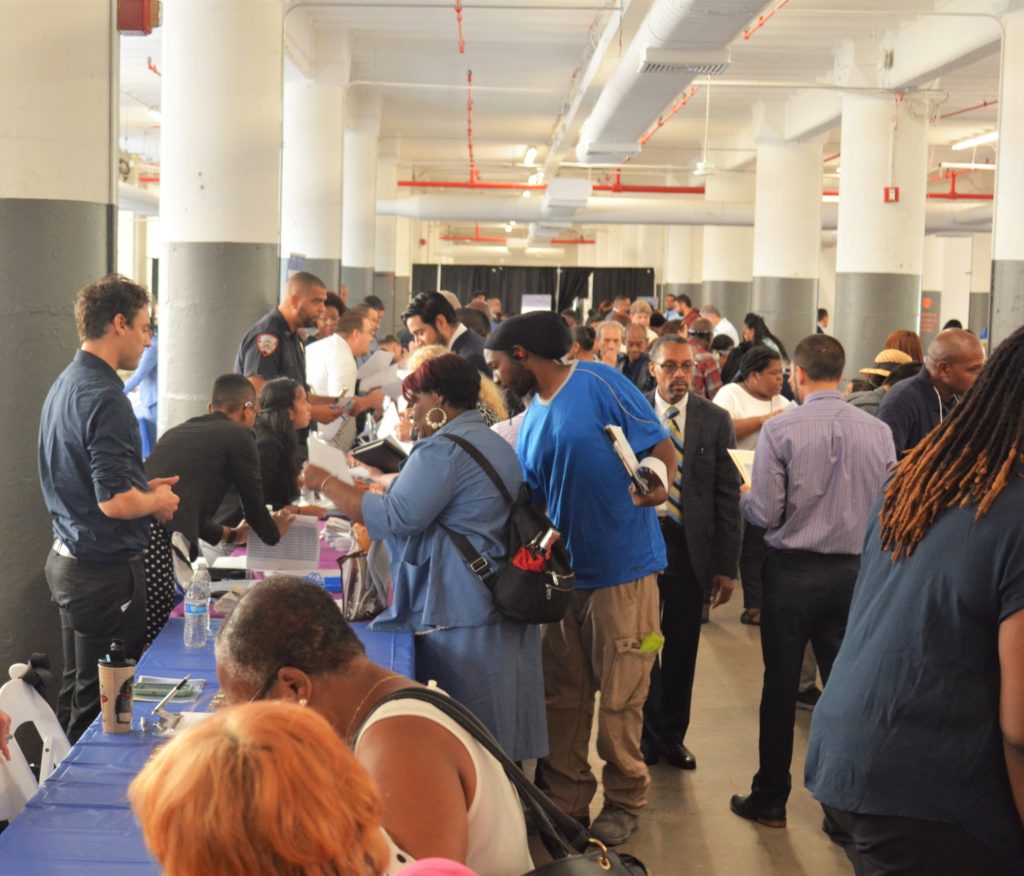
As he neared the end of his first 100 days in office recently, Batista spoke with The Bridge about his goals for the chamber. Among them: reaching out to young entrepreneurs, developing technology to better connect the chamber with its members, having a broader mix of industry types represented on its board, and boosting the chamber’s fundraising efforts.
An ‘Economic Development Engine’
When he stepped into his role last October, succeeding Andrew Hoan, Batista said he told the chamber’s board that he would “spend the first 100 days really listening to our members, our stakeholders and our partners to understand what the value proposition of the chamber is.”
Batista decided that as the borough’s “economic development engine,” the chamber needs to develop a sharper focus. “What I said to the board recently was, ‘We do 15 things, and in a lot of cases we’re one layer deep in those things. I’d rather do five things and be 15 layers deep.’”
One such goal is to increase the chamber’s loans to small business. The organization recently became certified by the Treasury Department as a Community Development Financial Institution (CDFI), which permits it to give out small loans ranging from $500 to $5,000. Batista said he would like to raise this to $50,000. “Loans that in most cases banks cannot give because of their requirements, we’re now able to step in there,” Batista said.
Another focus is jobs. Batista wants to create a more robust employment service to match employers with prospective workers, as well as boosting the chamber’s workforce-development role. With the rise of tech-driven companies in Brooklyn hubs like the Brooklyn Navy Yard and the Brooklyn Army Terminal, new jobs call for a higher level of skills than some of the old manufacturing jobs did. Batista wants to work with educators and business leaders to fill those skill gaps, he said.

Batista wants to think strategically, industry by industry, to see how the chamber can help them. Despite the decline of old-school manufacturing in the borough, hundreds of companies make products here, typically with increasing sophistication. Batista wants to help get those products sold across the U.S. and the globe.
The same line of thinking, he said, applies to a newer industry: tourism. Noting that the borough now has 55 hotels—the nightlife business is booming as well—Batista said the chamber is having conversations with local travel-industry proprietors this month to see what the chamber can do to bring even more tourists across the bridges from Manhattan.
Heritage and Family
Batista, whose ancestry is Dominican and Puerto Rican, graduated from Ft. Greene’s Bishop Loughlin Memorial, a Catholic college-prep high school, and attended college at another venerable Brooklyn school, St. Francis College, where he earned a BA in political science.
After college, he quickly dove into the field of economic development, serving in a succession of roles including director of development and finance for the Brooklyn borough president’s office. He stepped up to a city-wide role as chief operating officer of the Department of Housing Preservation and Development.
In many of his jobs, Batista notes, he has been “the first,” as in the first Hispanic to serve as executive vice president of the American Cancer Society’s New York region, the first as CEO of Big Brothers Big Sisters of NYC, and now the first as CEO of the Brooklyn Chamber.
Batista says that he brings a family approach to life and work. He still speaks with his mother on the phone every morning. (He and his wife have two grown children and a grandson.) “I believe in the idea of being a servant leader. I support the people around me,” he said.
“I always think that I’ve left every place better than I found it,” Batista added. “But you can’t do that by yourself. You have to build a team that helps you get that done.”
Drawing on His Previous Success
In leading Big Brothers Big Sisters of NYC, Batista doubled the number of children being served annually, to 6,000. On his watch, high-school graduation rates of participants rose eight percentage points, to 93%.
Among the tools he created was an app for the organization to help Bigs (the volunteers) and Littles (the youths) document their outings together. It also gave Bigs real-time data of how their Littles were doing in school. Batista believes a similar app could help the chamber connect better with its members, particularly young entrepreneurs.

Much of the growth in Brooklyn’s economy has come in new tech and information businesses, generally situated along the northern reaches of the borough, including Industry City, Downtown Brooklyn and Dumbo. “We have different types of businesses and we have to be able to react to all of them,” Batista said. “We haven’t been as successful as I would like in that space, and I’m committed to being more successful in that space. We have to be able to talk to them, in their language, in their interests.”
To make the chamber more appealing to a younger generation, he believes a rebranding is in order to make it “cooler,” with more relevant programming. Before the internet came along, Batista observed, the chamber was seen as a vital networking tool for local businesses. But with the arrival of search engines and social media, he believes the purpose of the chamber must become more all-encompassing. “We can’t just be the gatherer of people,” he said. “We have to be the provider of opportunities and commerce.”
Battling for Small Business Too
Small business is often whipsawed by the regulatory environment, Batista noted. Most recently, an apparent crackdown by the city’s Department of Buildings on non-conforming storefront signs created a potentially devastating burden on small business, but the outcry was so great that the City Council passed the Awnings Act to provide relief.
Batista said the chamber needs to be an advocate for small business when it’s threatened by overly burdensome regulations or legislation. “It seems to me from where I sit, the small business community is under siege right now,” he said. “A lot of legislation is being introduced that is really not helping small business.”

One such piece of legislation he mentioned was the City Council’s proposed “right-to-disconnect” bill, which would prohibit private companies with more than 10 employees from requiring them to answer calls, texts, or emails after work hours. (The bill was sponsored by Brooklyn’s own Rafael Espinal.) Batista also pointed to Mayor de Blasio’s proposal that all businesses with five or more employees should be required to provide two weeks of paid vacation every year, which Batista said would strain small businesses even further and should be challenged.
“I think it is our responsibility—it is my responsibility—to do the analysis, to get input from all the different players, but then to take a position and represent our membership because I think that’s what our membership wants,” Batista said.
“I have a particular passion and interest in helping the small business and the medium-sized business because I understand that journey,” he said.
Diversifying Directors and Funding
Two other major goals of Batista’s are diversifying both the Chamber’s board of directors and its funding sources. He wants to bring representatives of more varied industries onto the board to stay current with a changing local economy. (Banks, colleges and real-estate firms are already well-represented.)
At the same time, the chamber needs a broader array of funding sources. Currently, the organization relies on the government for 60% to 65% of its funding, Batista said.
When the Chamber didn’t receive one of the government grants it needed, that created budget strains and an incentive to find alternative revenue options. Batista said he will need the support of the board and members to help boost fundraising, as well as more must-see programming to attract sponsors and participants.
A big event coming up for the chamber is its annual winter gala on Feb. 25, starting at 6 p.m. in the Grand Ballroom at the New York Marriott at the Brooklyn Bridge. Advance registration is required.
Winterfest Chief Allegedly Used an Alias to Harass Vendors
Editor’s note: This story was originally published in the Brooklyn Eagle, including reporting by The Bridge contributor Patrick Smith.
Lena Romanova, organizer of the botched Winterfest holiday market now facing scrutiny from the Brooklyn district attorney, used a fictitious spokesperson named “Jennifer Crosby” to harass vendors and the press as the event unraveled, according to business owners who took part in the event.
“There is no Jennifer,” said Jeff Golden, owner of Bear Hands & Buddies and a merchant at Winterfest, which was organized by Millennial Entertainment Group. “Jennifer was Lena; it was her alter ego.”
Winterfest participants said Crosby engaged in a campaign of intimidation, terminating agreements on a whim and threatening legal action against those who spoke to the press about the event’s shortcomings. But Crosby was no more than an email address that provided Romanova anonymity to bully vendors when the festival collapsed, merchants told the Brooklyn Eagle.
The Eagle contacted all 50 vendors and the Brooklyn Museum, which hosted the fair in its parking lot. Of the 21 merchants that responded, not a single person met or spoke with Crosby on the phone.
Vendors who spoke to the press as the event struggled told the Eagle they received emails from Crosby suddenly terminating their contracts. One Winterfest merchant shared an email with the Eagle in which Crosby said the agreement was terminated for “making noise and false allegations.” The merchant later arrived at her booth to find the shop’s electricity outlets boarded up.

“You have a very uneducated reading of the agreement,” Crosby wrote to the vendor. “I suggest you get advise [sic] from a lawyer. … You are terminated and you need to leave the market immediately. This is not up for discussion.”
Other vendors pleaded with the Brooklyn Museum for help: “We [and] the rest of the vendor[s] fear for our personal safety and the safety of our store,” Johanna Guevara-Smiley wrote. “We sincerely ask for extra security these following holidays,” she added.
Another vendor told the Eagle, “I did not feel safe there.”
Joann Montalto from Brooklyn Bar Body & Bath referred to Crosby as the “infamous, mysterious finger-pointing and threat-making voice behind the cowardly operators of Millennial Entertainment Group.”
Neither Crosby, Romanova nor co-organizer Johan Rizki responded to repeated requests for comment, and an email sent to the spokesperson listed on Millennial’s contact page, Zane Friedman, bounced. The company’s Newton, Mass., phone number was disconnected, and the number listed on the Winterfest Vendor Agreement is also not in service.
Romanova is listed on Millennial’s website as CEO and president, but her LinkedIn profile says she is cofounder of Momentum Leisure Group, a business with no website.
Crosby’s name appeared on press releases promoting the event prior to negative publicity, and her email address is included on the contact page of Millennial’s website.
Beyond that, Crosby lacks a meaningful digital footprint. There are no social media accounts or a LinkedIn profile belonging to her, and she is only mentioned in articles relating to Winterfest. Only a YouTube account under her name exists, with two videos from October and November promoting the festival.
Several message threads reviewed by the Eagle show Crosby responding to emails addressed exclusively to Romanova and vice versa. In one instance, vendor Marty Krutolow of Marty’s V Burger asked, “Who are you?” after Crosby answered an email addressed only to Romanova.
“As you may notice, I included the last email you sent to Lena and copied her,” Crosby responded. “It goes without saying that I work for the company that rented you the chalet.”
Other vendors reported similar behavior.
“The first-ever email I had from Millennial Entertainment Group, I got a response from Lena even though I sent it only to Jennifer,” said one vendor who asked to remain anonymous for fear of legal retribution. “We really don’t think she’s real. We think it’s a front.”

Taylor Maatman, senior public relations manager at the Brooklyn Museum, told the Eagle that the museum had contact with Crosby only “via email after the market opened” and that they were “primarily in touch” with Rizki and Romanova.
Vendors soon began noticing similar writing styles between emails from Crosby and Romanova, most notably sentences formed in broken English with a threatening tone.
“We got an email that was very much in Lena’s voice, and that was the moment it clicked for me that Jennifer was Lena,” said another vendor who also asked to remain unidentified.
Crosby may not be the only fictitious person associated with Winterfest.
The Eagle received an expletive-filled message written in the same syntax from a supposed “Jenna Raul,” who said she was a vendor. The Eagle, however, reached out to all of the merchants at Winterfest and found that none of them have an employee by that name. In addition, a Google search does not bring up any relevant results for Jenna Raul.
Another employee, Zane Friedman, is listed on Millennial’s website as director of sales and sponsorships—but Friedman also has no digital footprint beyond a LinkedIn profile. A search for similar images on the internet revealed Friedman’s profile photo is actually an image of Swedish model Frida Gustavsson.
Members of the press were not spared from Millennial’s attempts to intimidate.
Patrick Smith, a journalist for The Bridge who wrote about the event’s troubles, said he received a phone call from an unidentified man on a blocked number threatening legal action after the article was published.
Emails from Crosby to the Eagle similarly warned of legal action if a video interview with Romanova was not taken down and was adamant that any mention of Romanova in articles be removed.
The market, which was advertised as a 40,000-sq.-ft. “world of holiday joy and wonder,” collapsed after several promised attractions proved underwhelming and others were absent entirely. For example, the event did not feature an advertised snow globe or slide, and the immersive chocolate experience was merely a tent serving instant hot cocoa.
Vendors complained of a lack of electricity in their booths, as well as rat and roach problems, and organizers using bullying tactics. Some attendees began comparing the event to the now infamous Fyre Festival.
When the event was cut from six to four days per week, many merchants asked for refunds, but their requests received no response. Attendees also demanded reimbursement to no avail after attractions they initially paid for were later offered for free.
“[The Brooklyn Museum is] extremely disappointed with the organizers of Winterfest, who failed to meet their obligations to us, the vendors and all of the dissatisfied patrons,” Maatman, the museum’s spokesperson, said.
“We are in talks with many of the vendors and are offering them space and time to open pop-up shops at the Museum for free one weekend this spring. Logistics are still in the works, but we are planning for this to take place during a high-traffic period for the Museum—likely during the months our Frida Kahlo exhibition is on view.”
Helen Peterson of the Brooklyn District Attorney’s office confirmed to the Eagle that the “complaints” against Winterfest are “being reviewed.”
Millennial, through Crosby, said in December that Winterfest will not return for the 2019 holiday season.
How Companies Scrambled to Help Federal Workers
The atrium at the Barclays Center arena is Brooklyn is typically filled with a stream of excited basketball fans, but this week the scene was entirely different. The cavernous space was stacked with groceries (milk, fruit, and vegetables) and personal-care items (diapers, baby shampoo) for federal workers who have been living without paychecks because of the partial government shutdown.
More than 600 federal workers showed up at arena to take advantage of the emergency pop-up shop, organized by the Food Bank for New York City and BSE Global, the company behind Barclays Center and the Nets basketball team, who also handed out free game tickets.
While President Trump announced a deal with congressional leaders today to temporarily reopen the government, workers are not completely out of the woods. The deal would reopen government departments for three weeks while Congress works on a border security package. But if a “fair deal” does not emerge by Feb. 15, Trump said, there could be another government shutdown, the Washington Post reported.

Thousands of federal workers across the U.S. have been stretched to the limit, struggling to pay rent and put food on the table since the shutdown on Dec. 24. About 800,000 workers have been affected, more than half of them deemed essential staff and required to work without compensation.
Across the U.S., there has been an outpouring of support from businesses and nonprofit organizations to offer essential items, financial relief, and professional advice to federal workers caught in the bind. “We’re here to help our customers, whether they’re a government worker, a government contractor or simply an employee at the diner across from a shuttered federal office,” JPMorgan Chase CEO Jamie Dimon wrote in a note to the bank’s employees.
In Brooklyn, some workers came with kids in tow, and some left work to pick up necessities. “In my own household, myself and my husband are federal government workers, so that’s two paychecks not coming in,” said a federal correctional officer, who asked not to be named. “And we have small children at home that we have to care for, child-care expenses to pay while we still go to work and not get compensated. So it’s very stressful.”
Making matters worse, some cash-strapped workers haven’t been able to afford transportation to their no-pay jobs. As a remedy, the correctional officer said her managers offered to allow workers to sleep overnight in the facility. A spokesperson for Brooklyn’s Metropolitan Detention Center said that it was just one of several measures put in place to assist the workers. “One avenue is providing interested staff with sleeping accommodations in a secure and empty part of the institution,” the spokesperson said in an email. “At no time are staff sleeping in inmate occupied areas.”

Thoughts of having a Brooklyn pop-up shop for federal workers first began when the shutdown started, said Margarette Purvis, president and CEO of the Food Bank for NYC. But it quickly became a commitment when they heard that February’s food stamps would be distributed in January instead, leaving families without support for next month.
“I think all of us can connect to the power of missing a paycheck,” Purvis said. “They’ve now missed two. These are the people who protect us, who make our government run.”
At the Brooklyn event, 600 volunteers showed up over the holiday weekend to pack food bags in preparation for the giveaway. The event also had a staffed table where attendees could learn more information about SNAP (food stamp) enrollment and where and how to file taxes.
Bruce McClary, a spokesperson for the National Foundation for Credit Counseling, compared the national outpouring of support to the response to a natural disaster. “Not in my recollection has there been such a universal response,” McClary told USA Today. “The only difference is this is a man-made disaster.”
Among other companies and organizations offering help:
GoFundMe
The crowdfunding company, GoFundMe, found a way to help workers who are struggling to afford groceries or other household necessities during the shutdown. The company created a fundraiser for furloughed federal employees, with a goal of $200,000. The company reached its goal on Tuesday, just three days after it launched the campaign.
Funds raised will be distributed to nonprofits across the U.S. that provide workers with hot meals, personal-care necessities, and household items.
“I hope the shutdown ends soon,” GoFundMe CEO Rob Solomon wrote in a statement. “In the meantime, please join me and help our fellow Americans by providing some short term relief. This is not about politics. This is lending a helping hand to someone in need.”
Hyundai
Car payments can be one of the most expensive bills that come due each month. Hyundai announced that it will defer all loan and lease payments for federal workers for one month during the shutdown.
“We recognize that there are many federal employees who are Hyundai owners and are not receiving their normal paycheck,” Brian Smith, chief operating officer of Hyundai Motor America, told Business Insider. “Hyundai is a brand that aims to make things better for its customers and this is our way of showing customers ‘we have your back’ during this uncertain time.”
Progress Residential
In Dallas, Texas, this property-management company is deferring payments on rentals for federal employees. The company is working individually with affected renters on deferring January and February rent payments. Renters must simply show a furlough letter or proof of employment with an affected government agency.
“This is a unique nationwide situation, and we view it as an opportunity to demonstrate how deeply we appreciate the work that our civil servants and military men and women do for our country,” Chaz Mueller, Progress Residential’s CEO, told Forbes. “We recognize the hardship that many of our residents may be facing due to the government shutdown and want to alleviate the anxiety those families are facing.”
PayPal
In light of the shutdown, PayPal set aside $25 million through its PayPal Credit program dedicated to furloughed government workers. Federal employees are eligible for an interest-free cash advance of up to $500 if they are new or existing customers. The program will end when employees receive their first paycheck after the shutdown ends.
“Setting up this fund to assist federal workers in their time of need is our way of giving back to the communities we are a part of,” PayPal CEO Dan Schulman told CNBC. “I think it’s really important that CEOs think about their companies as part of the communities they live in—and serve. When you do the right thing, good things come back multifold to you.”
Major Telecom Companies
T-mobile, AT&T and Verizon announced in early January their plans to help customers affected by the shutdown. Federal employees are able to speak with a customer service representative about rescheduling payments. All three companies will waive late fees.
During the shutdown, U.S. Bank has offered several options for its customers. The first is a small low-rate loan between $100 and $6,000, available for customers who any type of U.S. Bank product.
JPMorgan Chase
When the shutdown occurred in December, Chase bank reached out to customers to offer help, automatically refunding their checking account overdraft and service fees. The bank also activated its Special Care Line (888-356-0023) with a team of specialists who have extended payments on customers’ car loans, provided 90-day relief on their mortgages, and removed minimum payments on their credit cards.
In his message to employees, Chase CEO Dimon added that the banking company is committing $1 million to Feeding America and United Way Worldwide to provide meals, financial services, counseling, and other assistance to federal workers and their families in need.
U.S. Bank
The company launched new low-rate, quick loan for customers needing assistance during the shutdown. The bank is offering mortgage-relief options as well. Affected customers can call its designated government shutdown line to speak with a representative.
“U.S. Bank is committed to doing the right thing for our customers,” stated Andy Cecere, the company’s CEO. “We understand the financial pressure that many of our customers who serve our nation are now facing and we’re here to help.”
Judging by the response of federal workers in Brooklyn, the helping hand hasn’t been taken for granted. “This is a lot,” the correctional officer said. “It’s heartwarming to know that the city is really coming together to help us federal employees and realize the impact it does have on our families,” she said. “It makes me feel very good and restored my faith in society, because we were losing it for awhile.”
New York’s Food Bank has a webpage to help furloughed workers locate their nearest food pantry or soup kitchen.
Behold the New Giant of Dumbo, called Front & York
Surrounded by fences and orange construction material, 85 Jay St. has been a site of intrigue for most Dumbo locals, who have regarded the former parking lot as a dead zone in the bustling neighborhood. Today, developers finally unveiled the name of the development, Front & York, as well as more information about the highly-anticipated project.
Front & York, named after two bordering streets, will be a 21-story residential and retail complex, containing 408 one-to-four bedroom condominiums and 320 rentals, for a total of 728 apartment units spread out over two towers.
The building won’t be the tallest in Dumbo, but it will be by far the largest, housing enough residents to increase the neighborhood’s population by roughly 25%. Last June, The Bridge took an in-depth look at how the development will change the face of Dumbo.

Future residents will have luxurious amenities at their disposal, the developers said, including an underground parking lot that would hold 712 cars and a private park designed by Michael Van Valkenburg Associates, who planned the nearby Brooklyn Bridge Park. Outside the building will be wide, tree-lined sidewalks to create a plaza-like feel. The developers have earlier described amenities including a lounge, game room, grill area, kids area and screening room, plus rooftop swimming pools.
The building is designed by Morris Adjmi, whose work is known around New York City in locations like the Wythe Hotel in Williamsburg, the Theory Building in the Meatpacking District, and the Scholastic Building in SoHo.
Front & York will reflect the architectural and historical aspects of Dumbo, including arches on the ground floor inspired by the Manhattan Bridge and echoes of the neighborhood’s industrial warehouses.
In terms of mass-transit access, the building will be right across the street from the York Street F-train subway station, which will be handy for residents but has caused some local concern. Ridership at the station doubled from 2007 to 2016, to 10,246 per day. In the previous Bridge story, Dumbo Neighborhood Alliance member Doreen Gallo expressed concern that such a high-capacity development would create dangerously crowded conditions in the subway station, since there is only one entrance.
The development began as a joint venture by Los Angeles-based CIM Group, Brooklyn-based LIVWRK and Kushner Companies in 2016, when the three developers purchased the site for $345 million from the Jehovah’s Witnesses. Kushner sold its stake in 2017, removing itself from the project.
More details about the building, such as as sales and prices of the condos and an opening date, won’t be revealed until later this year.





